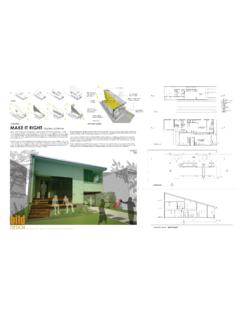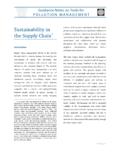Transcription of Architectural Design Principles and Processes for ...
1 _____ _____ 50 Architectural Design Principles and Processes for Sustainability Dr David Grierson University of Strathclyde Glasgow The paper is related to the video presented at CIC Start Online 2011 conference. Introduction Buildings consume energy and resources and generate waste on a huge scale. Current construction methods tie us into future patterns of resource and energy use, waste emissions and env ironmental damage. When poorly designed our buildings leave a lasting legacy for the next generation that extends adverse social, economic and environmental impacts throughout their life cycle. The Scottish Executive s A Policy for Architecture in Scotland acknowledges that the complex and challenging sustainability agenda requires fundamental change in our understanding of the nature and purpose of buildings and the role of building Design (Scottish Executive, 2006).
2 There are many definitions of what makes a bui lding sustainable with respect to social, economic and environmental issues (commonly referred to as the triple bottom line ); social in terms of adding to the quality of life for people, economic in terms of enhancing wealth, and environmental in terms of reducing the impact that buildings have on the natural environment. H owever the triple bottom line of sustainability is open-ended and ecological aspirations vary widely, more recently focussing on aspects relating to transport, water conservation, and biodiversity. A current significant focus is being placed on the energy and environmental performance of buildings, with specific key goals involving the reduction of associated carbon emissions and en ergy costs. I dentifying and developing more sustainable building materials and c onstruction techniques that can minimize waste and are non-polluting is recognised as an important aspect of sustainable building Design .
3 Sustainable buildings must be r esilient to climate change and be adaptable, flexible and durable in order to increase a building s life-span. This cradle to cradle approach refers to a bui lding that is designed to be d econstructed and where materials are capable of being recycled. Design parameters for sustainable buildings have therefore increased to encompass more complex performance related criteria, and the architect must adopt a more holistic perspective when designing. Sustainable buildings remain, however, far from the mainstream products. Indeed there are a limited number of contemporary exemplars and demonstration projects from which to learn good practice, although this number has expanded in recent years. The construction industry can be viewed as large and fragmented and slow to respond to change, preferring the tried and tested method.
4 The drivers to a more sustainable built environment will be increasing legislation and rising energy costs, if not ethics. The architect s role is central to the building Design process: the most energy efficient and environmentally friendly building must also be functional, durable and aesthetically pleasing. It is now vital that the architect has a comprehensive understanding of all the facets of sustainability in order to be able to engage with a wide range of disciplines and specialisms. The underlying hypothesis of the research is that a shift towards sustainable buildings requires a transformation of the Architectural Design process and the development of a new framework to navigate the complexities of sustainable Design within a c ontext that is promoting step change in building performance globally.
5 T he articulation of a framework that can be r esponsive to this context will involve the identification of approaches to sustainable building Design being adopted within current Architectural practice, and the emergence of a related typology. RESEARCH .. _____ _____ 51 Towards a Typology Research into the implementation of environmental management systems (International Organisation for Standardisation, 1996) within the wider context of sustainable development has raised issues of fundamental importance to the understanding of the concept if appropriate action is to be taken. In particular, consideration has been given as to how a practical realisation of such a system might be applied to the lifecycle of a bu ilding, including the Design phase (Grierson, 2009).
6 We need visions of a more sustainable future that can provide the current generation of designers and planners with sufficient motivation without impairing their capacity to learn what might be the best direction for change. At the same time we urgently need to improve the energy and environmental performance of the global built environment. An improved building Design process aided by appropriate management tools and r egulatory frameworks that address sustainable development issues has been suggested as a way forward, and is the subject of ongoing research (Grierson, 2009). The objectives of this part of the research are to investigate the Design Principles and Processes for sustainability and to explore them in action within current practice. These components were used in the analysis of exemplar case studies from practices.
7 A study, which aimed to gain the practitioner s perspective, was undertaken as dissertation work within the Masters of Research programme in Building Design and Management at the Department of Architecture, University of Strathclyde Glasgow during 2010 (Moultrie, 2010). This was achieved by engaging with a s mall sample of Scottish Architectural and multi-disciplinary practices actively involved in sustainable Design and by considering exemplar buildings via a case study analysis. Th e methodology was qualitative, involving face to face interviews and observational visits to the case study buildings. A context was established by reviewing literature focusing on the global environmental perspective, UK and Scottish legislation, sustainable Principles , blueprints, sustainable Processes and evaluation.
8 Analysis of the practitioner and client interviews, in combination with the case studies, allowed for discussion and r esponse to a n umber of research questions. To conclude the study a series of mapping exercises were carried out to allow for comparison and cross-referencing. An example within the paper describes the Principles Matrix which shows the overlapping Principles from selected literature (Table 1). Key components of a sustainable Design process are identified as the environmental brief, parameters, environmental strategies, evaluation and tools and techniques. These components were used in the analysis of exemplar case studies from practices. Table 2 maps the sustainable process onto the Royal Institute of British Architects (RIBA) Outline Plan of Work. An example of a case study building summary table, indicating relevant Processes and applicable Principles is given in Table 3.
9 ARUP s office in the refurbished Scotstoun House _____ _____ 52 Table 1: Principles Matrix Context Sustainable development was described in the 1987 Bruntland Commission s report (WCED, 1987) as, development that meets the needs of the present without compromising the ability of future generations to meet their own needs. I n achieving social and economic goals the commission recognised that ecosystems must be safeguarded and the depletion of natural resources minimized. At the same time investing in skills and the advancement of knowledge for the benefit of future generations must be prioritised. The European Union Energy Performance of Buildings Directive was published on the 4th January 2003 (EU, 2003). The overall objective of the Directive is to promote the improvement of energy performance of buildings within the Community taking into account outdoor climatic and local conditions, as well as indoor climate requirements and cost -effectiveness.
10 Each EU member state was required to transpose the Directive into law by the beginning of 2006 with a further three years being allowed for full implementation of specific articles. The UK Climate Change Bill (2007) set challenging targets for carbon reductions across the UK with a commitment to a 50% cut in carbon emissions from the built environment by 2020. Under the EU commitment the UK must deliver 15% of total energy from renewable sources. The zero carbon new building programme is seen as an active driver towards the renewable target. The UK policy is for all new homes to be zero carbon by 2016, all new schools zero carbon by 2016, public sector buildings by 2018 and potentially all new buildings by 2019. In August 2007, the Scottish Government appointed a panel of experts to make recommendations to improve the performance of buildings.



